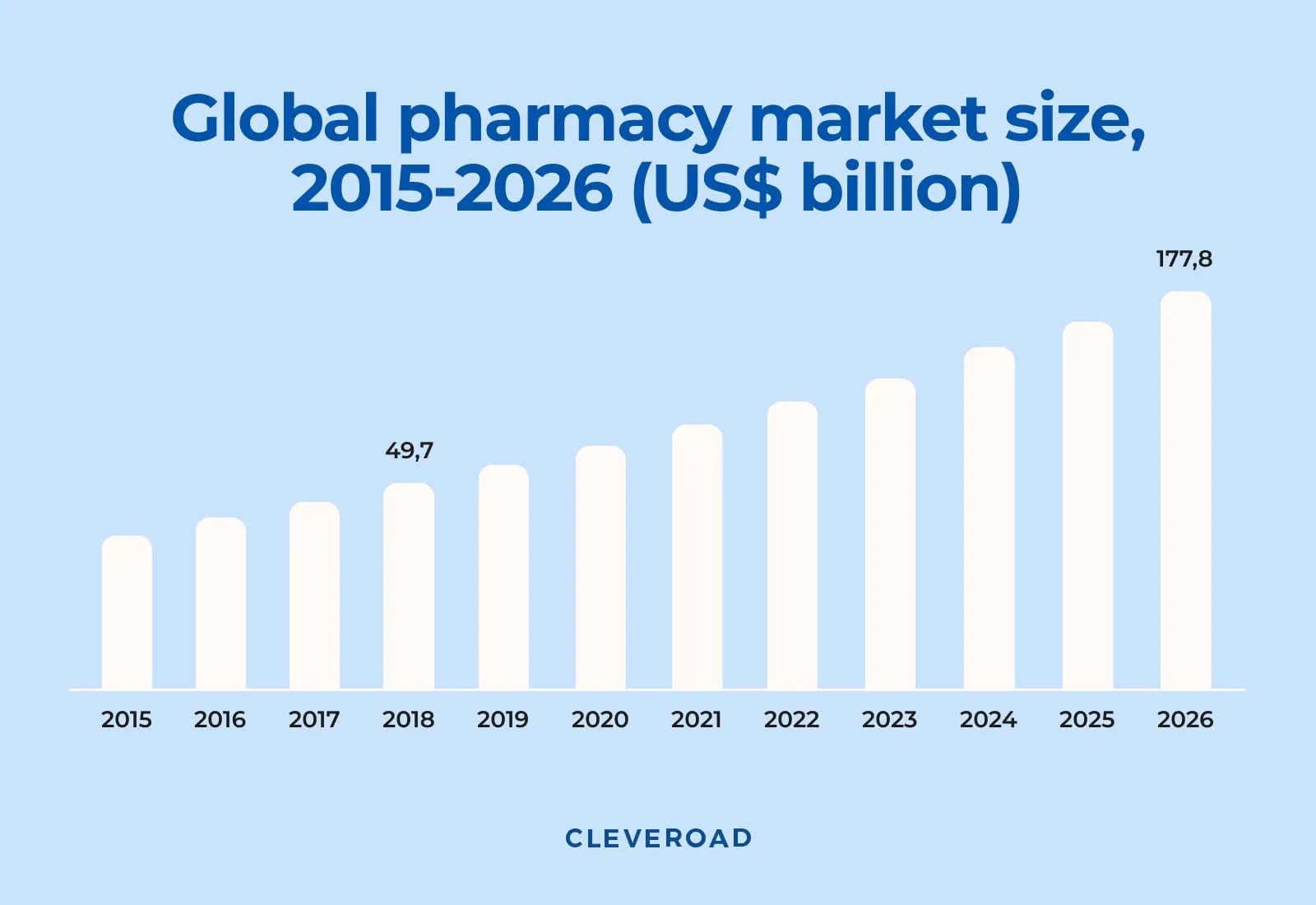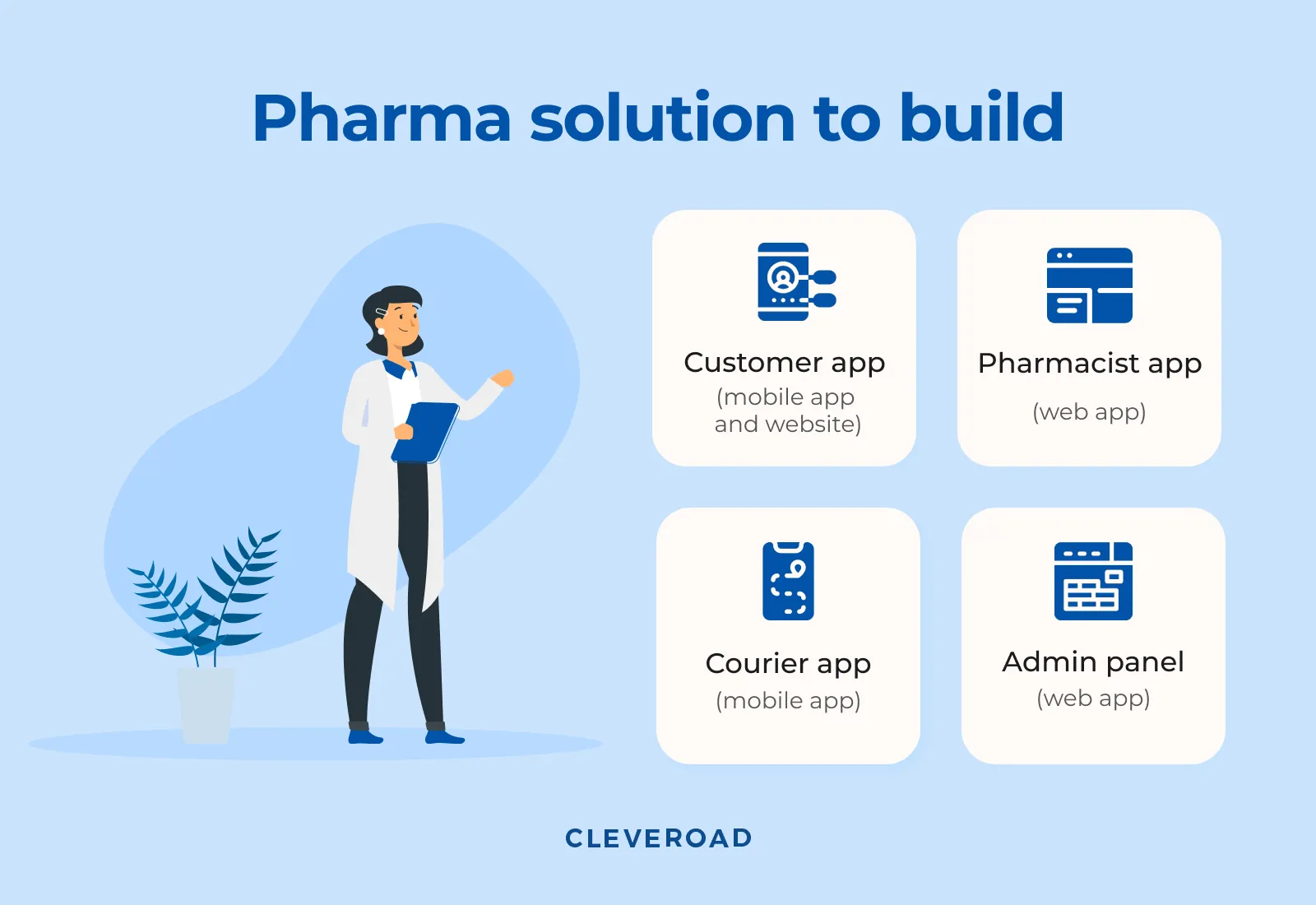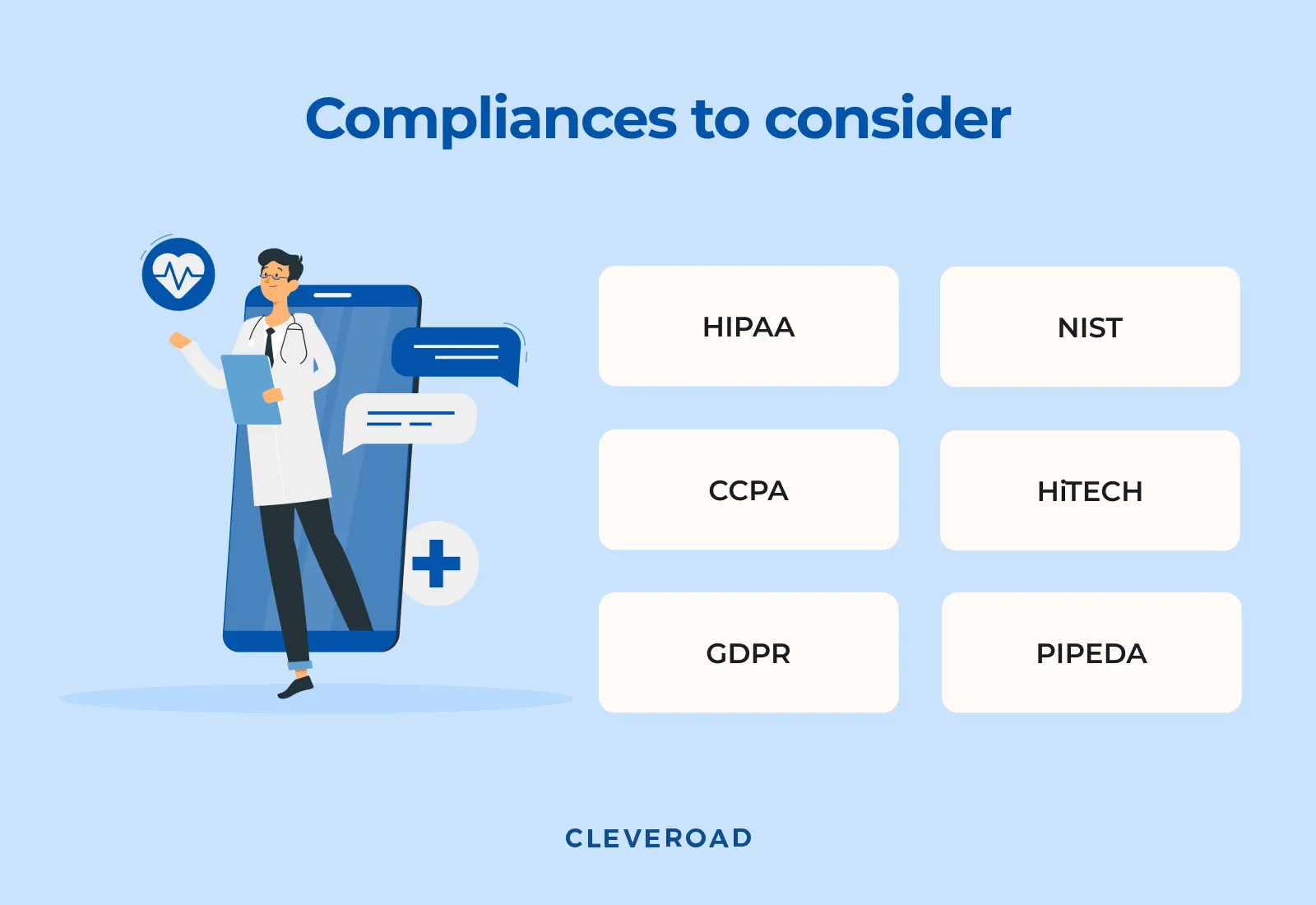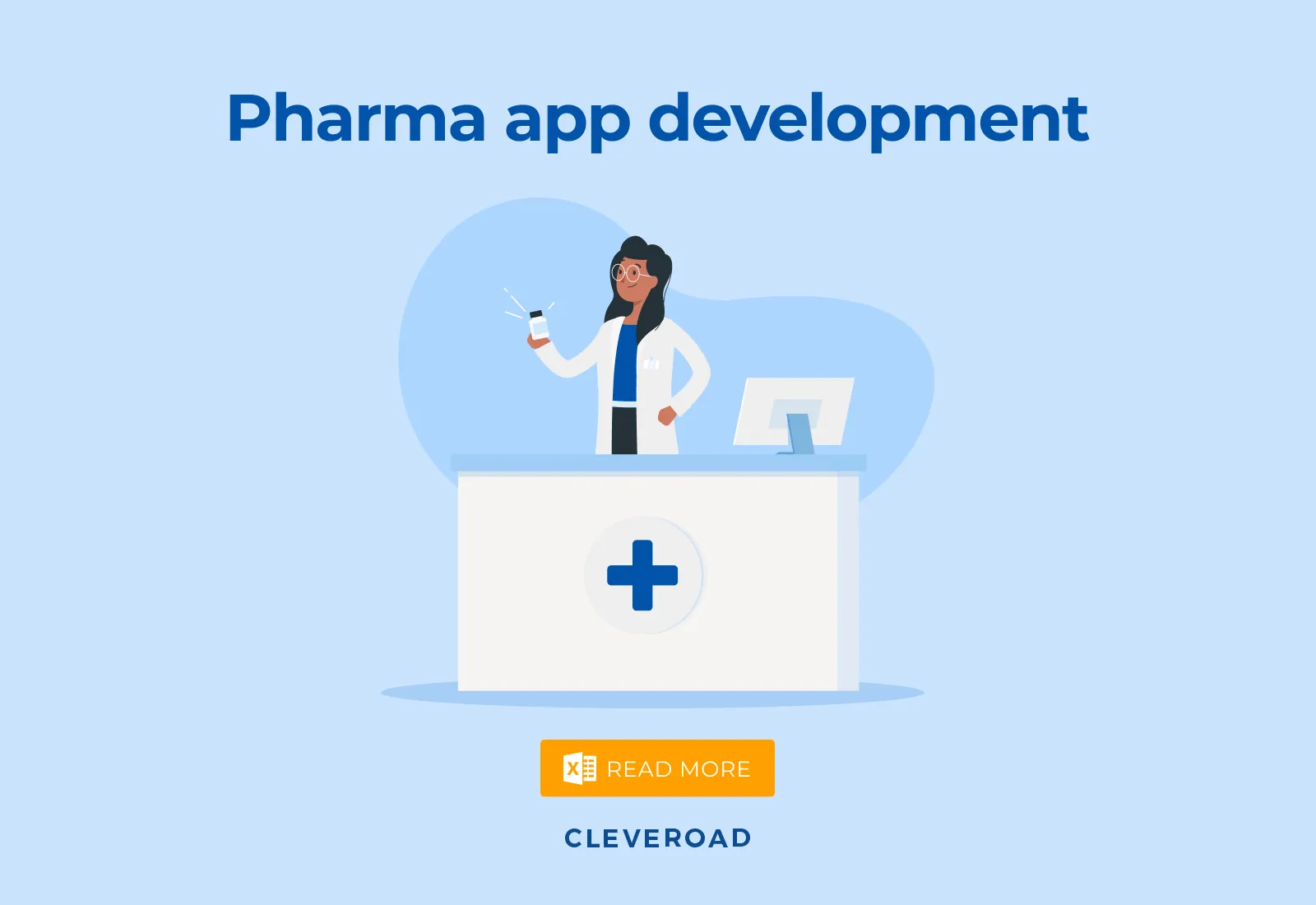Pharmaceutical App Development: Types and Must-Have Features
Updated 27 Jun 2023
9 Min
2320 Views
Pharmaceutical app development brings a lot of benefits to customers and businesses. Users can order and get their medicine without within the pharmacy and saving their time. Companies can increase their profit and gain customers’ trust and loyalty.
However, pharma app development takes time and money. Such solutions require an app for customers, another for couriers, and a pharmacy solution. Each solution has its own development challenges.
How to avoid all possible pitfalls? In this guide, you can find various development aspects: from types of pharmacy apps to required features.
Here’s what you’re going to learn:
ePharmacy Market Overview
On-demand delivery businesses gain a lot of profit from having a mobile app. Users tend to order goods, including medicine, on the go. These days, users prefer digital communication with pharmacists. According to the latest survey, 20% of customers who use pharma apps have claimed their satisfaction level is 23% higher than customers who don't use applications.
We’ve already covered healthcare app development, including cost, features, and compliance.
Ordering medicine online via the apps has revolutionized the customers’ capabilities and dependency on relatives and other people. Pharma apps are beneficial for older people and people with medical conditions.
The global online pharmacy market reached approximately $50 billion in 2018. And it’s predicted to grow about $178 billion by 2026.

Pharmacy market size, 2015-2026
Types of Pharma Apps To Develop
Starting pharmaceutical app development, you should pick the application type you want to build. It’s common to consider three types:
Apps for pharmacy marketplaces
These apps have a marketplace business model. They offer users to order and deliver drugs from nearby pharmacies. On the other side, pharmacies can list their store in the app and increase their profit.
Example: Glovo, Roadie
Apps for online pharmacy store
An online pharmacy store is a perfect option for independent pharmacies and medical companies that want to directly interact with their customers. Such solutions offer to purchase and deliver medicine through the app.
Example: Ride Aid, PharmEasy
Apps for pharmacy store chains
If you have an existing business — a pharmacy network — you can consider a pharma app development to increase sales and gain customers’ loyalty.
Example: GPC Mobile, CARiNG Pharmacy

Pharma app types
Points to Consider During Pharma App Development
The pharmaceutical app development requires creating an entire ecosystem to make the platform work for all parties.
A common pharma solution should consist of four parts:
- Customer app. Users can look through the list of medicine and make an order (drugs should be divided into categories). Also, users need an opportunity to upload their prescriptions for the pharmacists to collect the order. There's even a separate solution for such aims, which is an e-prescription app development.
- Pharmacist app. The pharmacists can see, manage, and collect orders for the couriers.
- Courier app. The application notifies couriers about new orders. They can see the order status and delivery address.
- Admin panel. The pharmacy owner and the team can manage the whole solution. They can add and delete pharmacies and drugs, handle payments, and more.
Of course, each solution has various features. To give you a hint, we’ve listed the must-have features to successfully develop a pharmacy management system.

Pharma app development
Customer app
The customer app is the most significant part of the project. It’s better to make a user-friendly UI/UX design to gain more users. Customers are quite spoilt these days. They don’t use the app with an unattractive or unclear design.
- Registration and login. You should offer several registration options to make the registration process fast. For example, integrate signup via social networks like Facebook or Google. Also, add email and password, phone number and password signups. Pharmaceutical app developers can use Facebook SDK and Google SDK.
- Search. Users should be able to search for nearby pharmacies using geolocation. Also, it’s good to integrate the search for required medicine. The user needs to see details about the chosen medicine and a ‘Buy’ button to put a drug in the card.
- Location tracking. Let customers track the courier’s location in real-time. You can integrate this feature via Google Location API for Android and Location Framework for iOS.
- Order and payments. Customers choose the required drugs and look through the order details (if they want to change something). Having put the drugs in the card, customers need to pay for the order. Developers should integrate a payment system like Braintree or Stripe.
- Push notification. They can notify users about their order status like accepted, delivering, and arrived. Pharmaceutical app developers can use Amazon SNS and Firebase Cloud Messaging.
Learn more about how to build MVP app, how can your business benefit from it, and go through some MVP examples.
Pharmacist app
This solution allows pharmacists to manage income orders. As a result, pharmacists can accept and collect orders for the couriers.
There are several must-have features:
- Order management. Workers should have various management options like accepting orders and changing their status.
- Integration of warehouse systems of pharmacies. Pharmacists need an opportunity to update the medicine in stock from warehouses.
Courier app
The courier app has to be straightforward but functional. There are several required features:
- Registration and login. Couriers need to sign up to use the app. It’s better to add sign in options similar to the customers’ app: social media, email and password, phone number and password.
- Navigation. You need to integrate maps with the fastest routes. To implement this feature, your pharmaceutical app developers can use Google Maps Platform for Android and Location Framework for iOS.
- Order details. Couriers need to see all the information about orders: restaurant address, delivery address, delivery time, and so on.
Admin panel
Admin panel allows managing all pharma solutions.
- Login. A secure login helps protect your data and customers’ personal information.
- Analytics. You can integrate analytics to track the number of orders, delivery time, revenue, and more.
- Payment management. You can charge fees from pharmacies or customers for using your solution.
Learn about the most notable pharma apps in our guide on medication management app development
Features and Technologies at a Glance
Pharmaceutical app development requires a scalable tech stack. For example, you need to use various programming languages for developing iOS and Android apps, Swift and Kotlin respectively. Also, you need a database.
As you can see, there are a lot of features to integrate. To give you a hint, there’s a table with the required features and technologies.
| Solution | Features | Tools |
Customer app | Registration and login | Facebook SDK, Google SDK |
Search | Elastic Search | |
Location tracking | Google location API, Location Framework | |
Order and payments | Braintree, Stripe | |
Push notifications | Amazon SNS, FCM | |
Pharmacist app | Registration and login | Facebook SDK, Google SDK |
Integration of warehouse systems of pharmacies | Highjump, Manhattan Associates, Oracle SCM Cloud, WMS Cloud, Soften | |
Order management | custom APIs | |
Courier app | Registration and login | Facebook SDK, Google SDK |
Navigation | Google Maps, Location Framework | |
Order details | ||
Admin panel | Login | Facebook SDK, Google SDK |
Analytics | ||
Payment management | Stripe, PayPal |
Compliances to Consider in Pharma App Development
The pharmacy industry requires complying with a bunch of legal and privacy regulations. Different countries have their own regulations that you should know and consider before launching the pharmacy app.

Compliances to consider
- HIPAA. Apps developed for the US market that process, record, and store Protected Healthcare Information (PHI) must strictly follow HIPAA regulations. Since 1996, these regulations have ensured the confidentiality, integrity, and availability of all electronically protected health information.
- CCPA. One more law of confidentiality for the USA. CCPA tends to be analogous to the European GDPR. These regulations make it obligatory to inform the client about what data is collected, prepare a free report on the collected data at the user’s request, and other rules.
- GDPR. These personal data protection rules were introduced in Europe in 2018. Every app that collects and processes personal data in the European Union must comply with them. GDPR applies to the company that processes information (for example, cloud storage) and the company that collects information (like a social network).
- NIST. One more collection of standards, tools, and technologies made to protect the information about users of medical applications in the United States. According to research, 70% of organizations consider the NIST framework as the best cybersecurity practice, but many say it requires significant investment.
- HiTECH. The HITECH Act expands the HIPAA requirements bringing several vital benefits to the patients. For instance, according to this act, patients get access to their Protected Health Information online. Patients have to be notified about any data violations related to their health profile. If a medical organization suffers from a breach that impacts 500+ patients, it’s necessary to inform the United States Department of Health and Human Services.
- PIPEDA. If you develop a pharmacy app that stores and processes information for the Canadian market, you have to comply with PIPEDA. There are data protection regulations similar to GDPR.
Cost of Pharma App Development
How much does pharmaceutical app development cost?
Since the pharmaceutical system requires four solutions, we’ve estimated each part separately. In the PDF below, you will find cost by features.
In the tables above, you can see an approximate development time by modules. Pharma app developers need 966 hours in total to implement those modules. We tend to divide that time into smaller parts (called sprints), so there are about 7 development iterations. Mind that to create an app you need not only the developers, but a whole team.
Here's the full team composition you'll need:
- Front-end developer - sprint 1-2
- Back-end developer - all sprints
- iOS developer (2X) - all sprints
- Android developer (2X) - all sprints
- UI/UX designer - sprint 1-5
- Business Analyst - sprint 1-5
- Project Manager - all sprints
- QA engineer - all sprints
- DevOps engineer - all sprints
- Team lead - all sprints
With this team composition and the amount of work, pharma app development will cost you approximately $137,100. We, as a software development company, can guarantee the successful product delivery meeting deadlines only if you hire all the specialists from the team.
Mind that the cost to build a healthcare app (particularly a pharma one) can changed depending on your project requirements and business goals. In you want to reduce your budget, it’s possible to follow team augmentation cooperation model. Team augmentation stands for hiring software engineers for project development. You manage the team on your own, so you’re responsible for the result.
How We Can Help You
Cleveroad is a pharma app development company from Eastern Europe that makes solutions for the healthcare and pharmaceutical industries. Our team of business analysts, software developers, and solution architects has a rich background in creating scalable applications following the business requirements and goals.
Recently, we’ve developed an app for a pharmacy chain. Our client wanted to create a solution for customers to order the required medicine. Having made the order, customers can pick the drug is the choosen pharmacy at a convenient time.
Unfortunately, our health-related projects are under NDA, so we can’t tell a lot of details.
We help pharma field solve many tech issues, including:
- Data analytics. Documentation and reporting for the legal, billing, HR departments.
- Accessibility. Access to medical prescription via digital personal health records.
- Reminders and alerts. Remind users to pick pills from a pharmacy and control appointments.
Fell free to look through our portfolio and ask about technical staff. Fill in this short contact form, and we’ll get back to you within 24 hours.
Pharmacy app stands for a solution that offers users to order medicine. After that, the courier delivers drugs. The pharma app also requires a solution for pharmacists, so they can manage orders.
It’s better to cooperate with a skilled software development team. They help you collect required features, create user-friendly UI/UX design, and develop scalable solutions for all user roles.
There are several must-have features like registration, search, order, payments, push notification, order management, and integration of warehouse systems of pharmacies.
You should consider developing an app for online pharmacy stores. An online pharmacy store is a perfect option for independent pharmacies and medical companies that want to directly interact with their customers. Such solutions offer to purchase and deliver medicine through the app.

Evgeniy Altynpara is a CTO and member of the Forbes Councils’ community of tech professionals. He is an expert in software development and technological entrepreneurship and has 10+years of experience in digital transformation consulting in Healthcare, FinTech, Supply Chain and Logistics
Give us your impressions about this article
Give us your impressions about this article
Comments
5 commentsThanks for sharing this high-rated and top blog information for software development. keep sharing and keep posting.
Thanks for sharing your expertise
This is a great read. I like your blog for useful articles. They help clear the development process for startuppers and understand the development cost (the most important part for startuppers)
Nice job
I want to develop a pharma app for my pharmacy chain in India. Thank you for creating this useful guide. I liked the part Compliance to consider the most. There are a lot of necessary data
